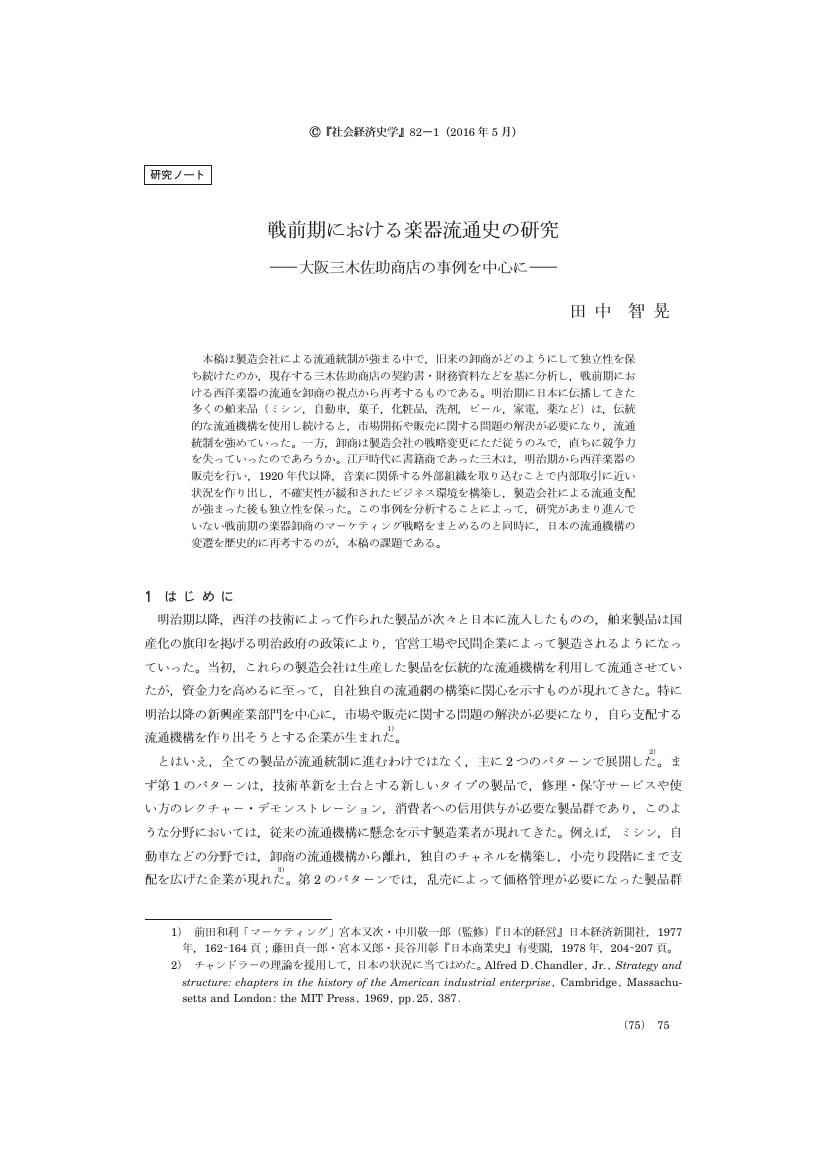10 0 0 0 OA 成熟市場をめぐるヤマハの鍵盤楽器ビジネス
- 著者
- 田中 智晃
- 出版者
- 経営史学会
- 雑誌
- 経営史学 (ISSN:03869113)
- 巻号頁・発行日
- vol.47, no.1, pp.1_49-1_74, 2012 (Released:2016-01-27)
The purpose of this paper is to examine the impact of technical innovation on marketing channels and the Yamaha Music School under the mature Japanese piano market since the 1980s. The dilemma of the piano industry (e.g., the low diffusion rate, about 25%) drastically changed due to digital technology. In this new competitive environment, Yamaha carried out the three strategic changes: releasing low cost digital instruments, recasting sales channels, and reconsidering the Yamaha Music School's management policy.In the early 1980s, newcomer Casio began producing and selling the Casiotone, a low cost digital instrument. Although Yamaha did not want to release cheap keyboard instruments which might decrease the demand for their leading products (the piano and electronic organ), in the late 1980s they launched Portasound (a Yamaha-made cheap keyboard) to compete against the Casio product. Moreover, Yamaha distributed this new product through the same mass retailers which dealt in Casiotones. Recasting their sales channel this way caused the old channel, the traditional exclusive distributor system, to struggle. However, it was important for Yamaha to maintain the traditional system, because exclusive distributors were skillful at selling expensive goods (pianos etc.) through consulting sales. Therefore, Yamaha reinforced the exclusive distributors by changing their form of profit-earning music schools from one in which the schools supported Yamaha through sales, to one in which Yamaha supported the schools through licensing. These schools became an important source of income in the face of reduced piano demand from 1980.Yamaha maintained their position as market leader through these three strategic changes in spite of the technological paradigm shift in which they lost the first mover advantage. Although the double structure of their sales channel (comprising exclusive distributors and mass retailers) resulted in lower sales capacity for their exclusive distributors, the exclusive distributors were able to change their primary focus to the music education business. Yamaha's unique sales channel, with educational facilities, continues to transform while developing new keyboard instrument businesses.
5 0 0 0 OA 戦前期における楽器流通史の研究 大阪三木佐助商店の事例を中心に
- 著者
- 田中 智晃
- 出版者
- 社会経済史学会
- 雑誌
- 社会経済史学 (ISSN:00380113)
- 巻号頁・発行日
- vol.82, no.1, pp.75-92, 2016 (Released:2018-05-26)
2 0 0 0 OA 日本楽器製造にみられた競争優位性
- 著者
- 田中 智晃
- 出版者
- Business History Society of Japan
- 雑誌
- 経営史学 (ISSN:03869113)
- 巻号頁・発行日
- vol.45, no.4, pp.4_52-4_76, 2011 (Released:2014-05-23)
This paper discusses issues related to the marketing strategy carried out by Nippon Gakki. In spite of numerous restrictions on sales, such as cost, size, and the need for periodical tuning and long training periods for users, the Japanese piano and organ market developed rapidly during the high economic growth period (1955-1973). What was behind the market expansion during this period? Mainly, it is attributed to three different factors: music education, credit sales, and the dealership system.Modern music education using instruments only began in the postwar period. The Japanese government officially announced the new school curriculum guidelines in 1958, which clearly stated that ‘students have to play the organ in school music class.’ This new curriculum boosted the demand for keyboard instruments, especially organs (reed organs). Around the same time, Nippon Gakki tried to further expand the market by encouraging early childhood music education, through the Yamaha music school.The second factor was the use of Yoyaku-hanbai (savings-type installment sales) which a Japanese sewing machine company created in the prewar period. This method was used by Nippon Gakki and Kawai Co. to enlarge the market to a wider income group. The third reason for the expansion was the dealership system of Nippon Gakki, which changed its system into a force that could achieve an ideal musical education, using the management resources of the dealership.Nippon Gakki grasped the trend of the times to firmly gain a competitive advantage; furthermore it constructed a stable marketing channel which was reinforced by the synergy of the three factors mentioned above, in addition to the territory system, the dealer-support system and the evolving sales force organization. This resulted in Japan becoming the largest piano and organ producer and consumer in the world.
1 0 0 0 IR ミシンとイギリス衣類産業(3)1880年代シンガー社ロンドン本部の経営戦略
- 著者
- 田中 智晃
- 出版者
- 東京経済大学経営学会
- 雑誌
- 東京経大学会誌. 経営学 = The journal of Tokyo Keizai University (ISSN:13486411)
- 巻号頁・発行日
- no.308, pp.57-76, 2020
- 著者
- 田中 智晃
- 出版者
- 東京経済大学経営学会
- 雑誌
- 東京経大学会誌. 経営学 = The journal of Tokyo Keizai University (ISSN:13486411)
- 巻号頁・発行日
- no.306, pp.61-77, 2020
1 0 0 0 IR ミシンとイギリス衣類産業(1)1880年代シンガー社ロンドン本部の経営戦略
- 著者
- 田中 智晃
- 出版者
- 東京経済大学経営学会
- 雑誌
- 東京経大学会誌. 経営学 = The journal of Tokyo Keizai University (ISSN:13486411)
- 巻号頁・発行日
- no.304, pp.73-90, 2019
- 著者
- 田中 智晃
- 出版者
- 社会経済史学会 ; 1931-
- 雑誌
- 社会経済史学 = Socio-economic history (ISSN:00380113)
- 巻号頁・発行日
- vol.82, no.1, pp.75-92, 2016
1 0 0 0 戦前期における楽器流通史の研究:大阪三木佐助商店の事例を中心に
- 著者
- 田中 智晃
- 出版者
- 社会経済史学会
- 雑誌
- 社会経済史学 (ISSN:00380113)
- 巻号頁・発行日
- vol.82, no.1, pp.75-92, 2016
